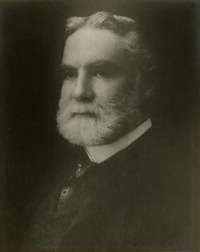William McMurtrie
| William McMurtrie | |
|---|---|
 Chemists Club President, 1903-1904 | |
| Born |
March 10, 1851 Belvidere, New Jersey |
| Died | May 14, 1913 (aged 62) |
| Nationality | United States of America |
| Education | Ph.D. |
| Alma mater | Lafayette College |
| Occupation | Chemist |
| Spouse(s) | Helen Douglass |
| Children |
Douglas C. Helen Douglas |
| Parent(s) |
Abram McMurtrie Almira Smith |
William McMurtrie (March 10, 1851 – May 14, 1913)[1] was an American chemist.
Born on a farm[2] near Belvidere, New Jersey,[1] the son of Abram McMurtrie and Almira Smith, William matriculated to Lafayette College where he graduated with a mining engineer degree in 1871—the school did not then offer a degree program in chemistry, his primary interest.[2] He undertook graduate studies at the College during 1871–1872[3] and was appointed as an assistant chemist with the United States Department of Agriculture.[4] In 1873, he was named Chief Chemist for the department; a post he would hold until 1878.[5] He was awarded a Ph.D. from Lafayette in 1875—the first doctorate in chemistry awarded at the school.[3] On April 5, 1876 he was married to Helen Douglass and the couple would have two children.[4]
Dr. McMurtrie traveled to the Paris Exposition in 1878 as representative of the Department of Agriculture.[1] He became a special agent of the Department in 1879, collecting information regarding agricultural technology. The following year, he served as a representative for the commissioner of agriculture at an international exhibit in Philadelphia for sheep, wool, and wool products.[4] Published in 1880,[6] his Report on the culture of the sugar beet and the manufacture of sugar therefrom in France and the United States helped to launch the sugar beet industry in the United States.[1]
From 1882 until 1888, Dr. McMurtrie was professor of chemistry at the University of Illinois.[3] In 1884, he was named chemist for the Illinois State Board of Agriculture,[1] then become chemist for the Illinois Agricultural Station in 1886. He entered the commercial sphere in 1888 when he moved to New York to work as chemist for the New York Tartar Company.[2] In 1896, Dr. McMurtrie was chosen vice president of the chemistry section for the American Association for the Advancement of Science.[4] He was selected president of the American Chemical Society in 1900.[7] He served as a trustee for Lafayette College from 1906 until 1912.[3] During his career he was the author of numerous reports prepared for the U.S. Department of Agriculture.[4]
Awards and honors
- Chevalier de Merite Agricole, 1883[2]
References
- 1 2 3 4 5 True, Alfred Charles (1937), "A History of Agricultural Research in the United States, 1607–1925", Miscellaneous Publication No. 251, United States Department of Agriculture, pp. 50–51.
- 1 2 3 4 Hart, Edward (August 8, 1931), "William McMurtrie", Science, 38 (971), pp. 185–187, Bibcode:1913Sci....38..185H, doi:10.1126/science.38.971.185, JSTOR 1639714.
- 1 2 3 4 Egolf, Roger A. (2006), "The History of Chemical Education at Lafayette College" (PDF), United States Department of Agriculture, Special report, 30 (1), pp. 41–50, retrieved 2013-08-17. See p. 45.
- 1 2 3 4 5 White, James Terry (1904), The National Cyclopaedia of American Biography, 12, James T. White & Company, p. 206.
- ↑ FDA Organizational Histories, U.S. Food & Drug Administration, August 6, 2013, retrieved 2013-08-16.
- ↑ McMurtrie, William (1880), "Report on the Culture of the Sugar Beet and the Manufacture of Sugar Therefrom in France and the United States", United States Department of Agriculture, Special report, U.S. Government Printing Office (28).
- ↑ ACS President: William McMurtrie (1851–1913), American Chemical Society, retrieved 2013-08-16.
External links
- Works by or about William McMurtrie at Internet Archive
- "Search Results: McMurtrie, William, 1851-1913", The Online Books Page, University of Pennsylvania, retrieved 2013-08-17.